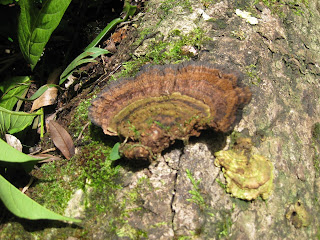Hiking the Rincon De La Vieja Volcano
Today our guide drove us two hours to an active volcano. Because it is still active, we could not go to the crater. It is so tall, that it would have taken an 8 hour hike just to go to the summit. However, our 5 hour hike unveiled some amazing discoveries for us. The base of the volcano is a tropical rain forest. This particular rain forest is home to the huge Strangler Fig, which actually grow around other trees and strangles them to death. Below are several pictures of the strangler figs we saw on our hike.
Strangler figs will grow up around a tree and thicken up until they actually kill the tree. When the tree dies, it decays and eventually leaves a hollow place inside the strangler tree. The strangler tree survives because it has reached the top of the forest and receives sunlight.
Below is a heated spring. The underground magma was heating the water. Usually magma is several miles deep but this magna was close to the underground spring which caused the water to become so hot it was boiling!!
Below is a picture and a video of a fumarole. Fumaroles are vents from which volcanic gas escapes into the atmosphere. They may persist for decades or centuries if they are above a
persistent heat source (active Magma chamber) or disappear within weeks to months if they occur atop a fresh volcanic deposit that quickly cools. The temperature of this fumarole range from 192-248 degrees (F). The gases can be dangerous if inhaled. Fumaroles are always a sign of an active volcano!
We are standing in front of a bubbling mud pit. The temperature was between 192-248 degrees Fahrenheit. (water boils at 212 degrees Fahrenheit.)
Crossing bridges was always Mrs. Ogle's favorite part!
This was our guide, Alejandro, who seemed to know everything about the plants and wildlife. Here he was showing us how orchids were growing on this piece of wood. To be a tour guide in Costa Rica, you have to go to through extensive training and pass certification exams. We were amazed at his knowledge of everything to do with Costa Rica. We were the students today and we were very glad there was not a test at the end of the hike!
Look at this seed (below) still hanging on to this baby seedling. I wonder if this young tree will make it to adulthood! Competition for light is fierce in a rain forest! Only the strong survive!
Dragonfly
Decomposing trees that give nutrients back to the soil.
This interesting looking mushroom is a type of fungi. It reproduces by letting out a powder through the hole in the top.
Fungi doing its job of decomposing this fallen tree.
Where the red fern grows.....
Look at all these insects on this leaf. They look similar to ladybugs.
This is a termite mound. The termites build their nests out of pieces of soil that they use their saliva to glue together, along with their own excrement.
An ant cutter mound (below)
Video of an ant cutter mound
Costa Rica will be opening this Geothermal Plant in 2015. This is a perfect example of how volcanoes can be constructive. It will be able to supply enough electricity for 100,000 homes! It uses the steam from the heated water underground. The water is heated from the magma chambers that are close to the surface. Alaska, Hawaii, and Iceland also use energy generated from geothermal sources.
These green pipes are taking the steam from underground and transporting it to the Geothermal Plant to be turned in to electricity.
After a long day, we were treated to a traditional Costa Rican meal. Costa Ricans eat beans and rice at almost every meal. (yes, breakfast too). They eat beef, chicken, and fish, along with a lot of fresh fruit. We ate a lot of plantain. Plantains are like bananas but sweeter.
We needed to get some rest before our next day of ziplining!!































.JPG)
.JPG)
.JPG)
.JPG)
.JPG)
.JPG)
.JPG)

.JPG)
.JPG)


.JPG)

.JPG)
.JPG)

.JPG)
.JPG)

.JPG)
.JPG)
.JPG)